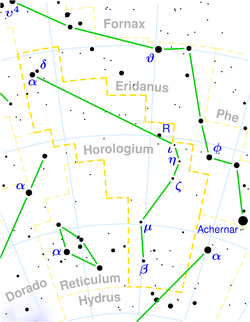R Horologii
 R Horologii (R) in Horologium | |
| Observation data Epoch J2000.0 Equinox J2000.0 | |
|---|---|
| Constellation | Horologium |
| Right ascension | 02h 53m 52.77465s[1] |
| Declination | −49° 53′ 22.7330″[1] |
| Apparent magnitude (V) | 7.22[2] |
| Characteristics | |
| Spectral type | M5-7e[3] |
| B−V color index | 1.044±0.011[2] |
| Variable type | Mira Ceti[4] |
| Astrometry | |
| Radial velocity (Rv) | +60.0±4.4[5] km/s |
| Proper motion (μ) | RA: +125.698[1] mas/yr Dec.: +35.975[1] mas/yr |
| Parallax (π) | 3.1999 ± 0.3632[1] mas |
| Distance | approx. 1,000 ly (approx. 310 pc) |
| Details | |
| Temperature | 2,200[6] K |
| Other designations | |
| Database references | |
| SIMBAD | data |
R Horologii is a red giant star approximately 1,000 light-years away in the southern constellation of Horologium.[8] It is a Mira variable with a period of 404.83 days,[9] ranging from apparent magnitude 4.7 to 14.3—one of the largest ranges in brightness known.[10] The star is losing mass at the rate of 5.9×10−7 M☉·y−1.[6]
References
- 1 2 3 4 5 Brown, A. G. A.; et al. (Gaia collaboration) (August 2018). "Gaia Data Release 2: Summary of the contents and survey properties". Astronomy & Astrophysics. 616. A1. arXiv:1804.09365. Bibcode:2018A&A...616A...1G. doi:10.1051/0004-6361/201833051.
- 1 2 Anderson, E.; Francis, Ch. (2012), "XHIP: An extended hipparcos compilation", Astronomy Letters, 38 (5): 331, arXiv:1108.4971, Bibcode:2012AstL...38..331A, doi:10.1134/S1063773712050015.
- ↑ Keenan, Philip C. (June 1966). "A Catalogue of Spectra of Mira Variables of Types ME and Se". Astrophysical Journal Supplement. 13: 333. Bibcode:1966ApJS...13..333K. doi:10.1086/190139.
- ↑ Samus', N. N; Kazarovets, E. V; Durlevich, O. V; Kireeva, N. N; Pastukhova, E. N (2017). "General catalogue of variable stars: Version GCVS 5.1". Astronomy Reports. 61 (1): 80. Bibcode:2017ARep...61...80S. doi:10.1134/S1063772917010085.
- ↑ Gontcharov, G. A. (November 2006), "Pulkovo Compilation of Radial Velocities for 35495 Hipparcos stars in a common system", Astronomy Letters, 32 (11): 759–771, arXiv:1606.08053, Bibcode:2006AstL...32..759G, doi:10.1134/S1063773706110065.
- 1 2 Danilovich, T.; et al. (October 2017), "Sulphur-bearing molecules in AGB stars. I. The occurrence of hydrogen sulphide", Astronomy & Astrophysics, 606: 14, Bibcode:2017A&A...606A.124D, doi:10.1051/0004-6361/201731203, A124
- ↑ "R Horologii". SIMBAD. Centre de données astronomiques de Strasbourg. Retrieved 18 March 2016.
- ↑ van Leeuwen, F. (2007). "Validation of the new Hipparcos reduction". Astronomy and Astrophysics. 474 (2): 653–64. arXiv:0708.1752. Bibcode:2007A&A...474..653V. doi:10.1051/0004-6361:20078357.
- ↑ Templeton, M. R.; Mattei, J. A.; Willson, L. A. (2005). "Secular Evolution in Mira Variable Pulsations". The Astronomical Journal. 130 (2): 776. arXiv:astro-ph/0504527. Bibcode:2005AJ....130..776T. doi:10.1086/431740.
- ↑ Privett, Grant; Jones, Kevin (2013). The Constellation Observing Atlas. New York, New York: Springer Science & Business Media. p. 102. ISBN 9781461476481.
External links
This article is issued from
Wikipedia.
The text is licensed under Creative Commons - Attribution - Sharealike.
Additional terms may apply for the media files.